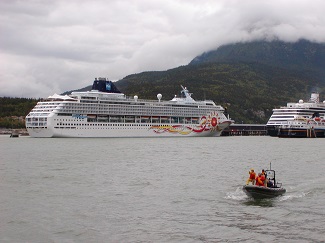Cruise Ship Discharges and Studies
The Basics
 Docked cruise ships in Skagway Harbor, Alaska.There are more than 230 cruise ships operating world wide. Cruise ships are akin to floating cities, providing many of the same services that small cities or towns provide to their citizens. These vessels can carry as many as 3,000 passengers and crew members, and often operate in coastal waters. As the cruise ship industry continues to expand, there is an increasing concern about the environmental impacts of cruise ship discharges.
Docked cruise ships in Skagway Harbor, Alaska.There are more than 230 cruise ships operating world wide. Cruise ships are akin to floating cities, providing many of the same services that small cities or towns provide to their citizens. These vessels can carry as many as 3,000 passengers and crew members, and often operate in coastal waters. As the cruise ship industry continues to expand, there is an increasing concern about the environmental impacts of cruise ship discharges.
-
bilge water (water that collects in the lowest part of the ship's hull and may contain oil, grease and other contaminants)
-
sewage
-
graywater (waste water from showers, sinks, laundries and kitchens)
-
ballast water (water taken onboard or discharged from a vessel to maintain its stability)
-
solid waste (food waste and garbage)
These discharges can have impacts on water quality. Impacts depend on the characteristics of the discharge (e.g., constituents present, levels of discharge) and the characteristics of the receiving waters (e.g., currents, temperature).
Work to Date on Cruise Ship Discharges
Cruise Ship Discharge Assessment Report (2008)*
-
what the waste stream is and how much is generated
- what laws apply to the waste stream
- how the waste stream is managed
- potential environmental impacts of the waste stream
- ongoing actions by the federal government to address the waste stream
- a wide range of options and alternatives to address the waste stream from cruise ships in the future
Plume dilution study (2008)*
 Small EPA vessel sampling cruise ship discharges.The EPA, in collaboration with the Alaska Department of Environmental Conservation, conducted a survey to study the near-field dilution of treated sewage and graywater discharges from six docked cruise ships in Skagway Harbor, Alaska during July 2008. Rhodamine WT (a fluorescent dye) was added to the treated effluent to facilitate observation of the discharge plume as it mixed with the receiving waters.
Small EPA vessel sampling cruise ship discharges.The EPA, in collaboration with the Alaska Department of Environmental Conservation, conducted a survey to study the near-field dilution of treated sewage and graywater discharges from six docked cruise ships in Skagway Harbor, Alaska during July 2008. Rhodamine WT (a fluorescent dye) was added to the treated effluent to facilitate observation of the discharge plume as it mixed with the receiving waters.
Nitrogen compounds sampling report (2005)*
The EPA sampled wastewater from four cruise ships that operated in Alaska during the summer of 2005, to collect information on nutrients in cruise ship wastewater.
Alaskan cruise vessel survey (2004)*
In 2004, the EPA distributed a "Survey Questionnaire to Determine the Effectiveness, Costs, and Impacts of Sewage and Graywater Treatment Devices for Large Cruise Ships Operating in Alaska" to all cruise ships authorized to carry 500 or more passengers that operated in Alaska at the time.
The final version of the survey (approved by the Office of Management and Budget), associated Federal Register notices, supporting documents and comments received can be found at www.regulations.gov under the EPA's docket ID: EPA-HQ-OW-2003-0081.
Sampling reports (2004)*
 Two cruise ships docked in Skagway Harbor, Alaska with a small EPA research vessel in the foreground.The EPA sampled wastewater from four cruise ships that operated in Alaska during the summer of 2004. The purpose of this sampling was to characterize graywater and sewage generated onboard and to evaluate the performance of various advanced treatment systems.
Two cruise ships docked in Skagway Harbor, Alaska with a small EPA research vessel in the foreground.The EPA sampled wastewater from four cruise ships that operated in Alaska during the summer of 2004. The purpose of this sampling was to characterize graywater and sewage generated onboard and to evaluate the performance of various advanced treatment systems.
Plume tracking survey (2001)
The EPA conducted a plume tracking survey to study the dilution of cruise ship discharges from wastewater systems in offshore waters.
Public hearings (2000)
The EPA, together with the U.S. Coast Guard and other Federal agencies, solicited public input on the issue of cruise ship discharges during public hearings in Los Angeles, Juneau and Miami.
*For access to these reports, please submit a request through the Contact Us link at the bottom of this page.
